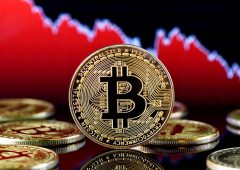Fear is Dominating the Market, Investor Sentiment Plummets
08.09.2024 10:00 1 min. read Alexander StefanovThe recent collapse of the crypto market has pushed investor sentiment into the "extreme fear" zone relative to Bitcoin's fear and greed index.
The index, which ranges from 1 to 100, has levels such as “extreme fear,” “fear,” “neutral,” “greed,” and “extreme greed” to gauge how investors feel about the market. The index is currently at level 23 and reflects the deep sense of fear among investors.

Interestingly, when the index reaches extreme levels, it often signals a potential price swing in the opposite direction. Historically, when the index enters the zone of extreme fear, it often marks a market bottom followed by a price recovery. For example, in August the index fell to 20 before the price of Bitcoin briefly recovered.
Despite this possible signal of a bottom, however, a recovery may not be imminent. Historically, September has been a bearish month for Bitcoin, with negative returns recorded.
Looking ahead, October typically brings more positive market action. If historical trends continue, the crypto market could recover after the end of September, providing some hope for investors facing the current downturn.
-
1
Michael Saylor Urges Apple to Buy Bitcoin
11.06.2025 9:00 1 min. read -
2
Bitcoin Nears Key Support Levels Amid Growing Market Uncertainty
10.06.2025 18:00 1 min. read -
3
Bitcoin Price Prediction: Can the Genius Act Push Bitcoin to $200K?
20.06.2025 22:52 3 min. read -
4
Strategy’s Michael Saylor Says Bitcoin’s Volatility Era Is Over
13.06.2025 8:00 1 min. read -
5
Quantum Computing Won’t Kill Bitcoin, Says Michael Saylor
10.06.2025 12:00 1 min. read
Strategy Boosts Bitcoin Holdings to 597,325 BTC with Latest Purchase
Bitcoin giant Strategy has added another 4,980 BTC to its reserves in a purchase worth approximately $531.9 million, according to Executive Chairman Michael Saylor.
Veteran Trader Peter Brandt Shares Simple Wealth Strategy with Bitcoin at Its Core
According to renowned market veteran Peter Brandt, trading isn’t the path to prosperity for the vast majority of people.
Why Bitcoin Is Stuck Despite Wall Street Demand
Charles Edwards, founder and CEO of Capriole Investments, has offered a fresh perspective on Bitcoin’s stalled price movement near the $100,000 mark, despite growing institutional enthusiasm.
Metaplanet Now Holds 13,350 BTC Worth $1.4 Billion
Metaplanet has expanded its Bitcoin treasury with a new acquisition of 1,005 BTC valued at approximately $108.1 million, further cementing its status as one of the largest corporate holders of the digital asset.
-
1
Michael Saylor Urges Apple to Buy Bitcoin
11.06.2025 9:00 1 min. read -
2
Bitcoin Nears Key Support Levels Amid Growing Market Uncertainty
10.06.2025 18:00 1 min. read -
3
Bitcoin Price Prediction: Can the Genius Act Push Bitcoin to $200K?
20.06.2025 22:52 3 min. read -
4
Strategy’s Michael Saylor Says Bitcoin’s Volatility Era Is Over
13.06.2025 8:00 1 min. read -
5
Quantum Computing Won’t Kill Bitcoin, Says Michael Saylor
10.06.2025 12:00 1 min. read


